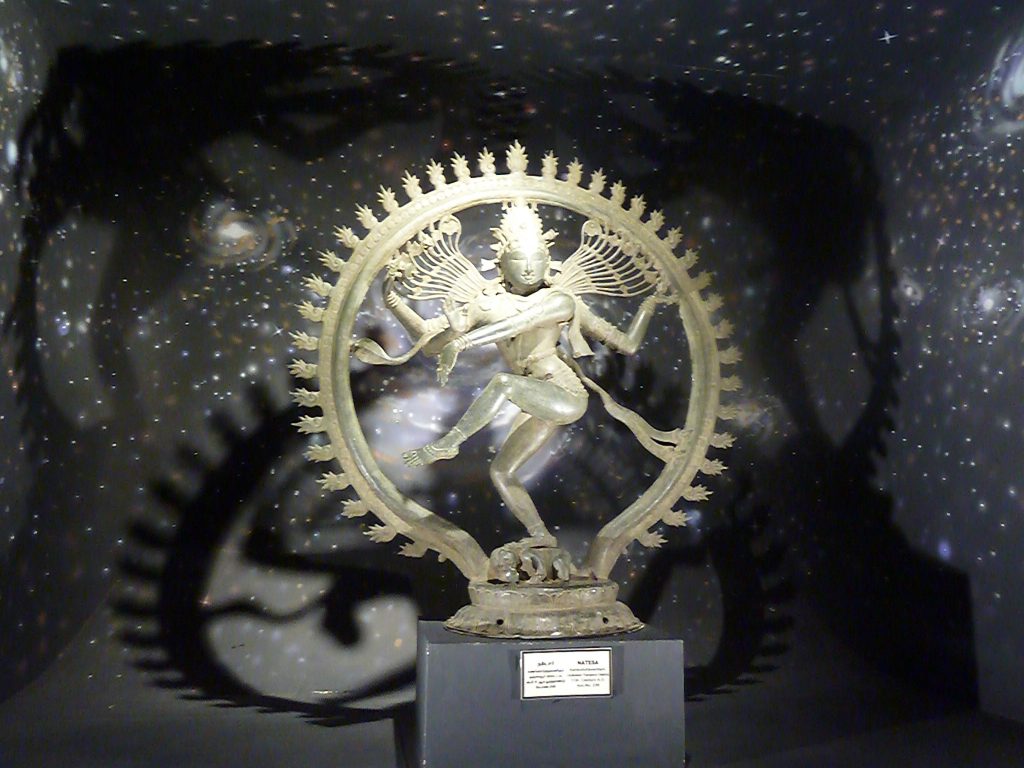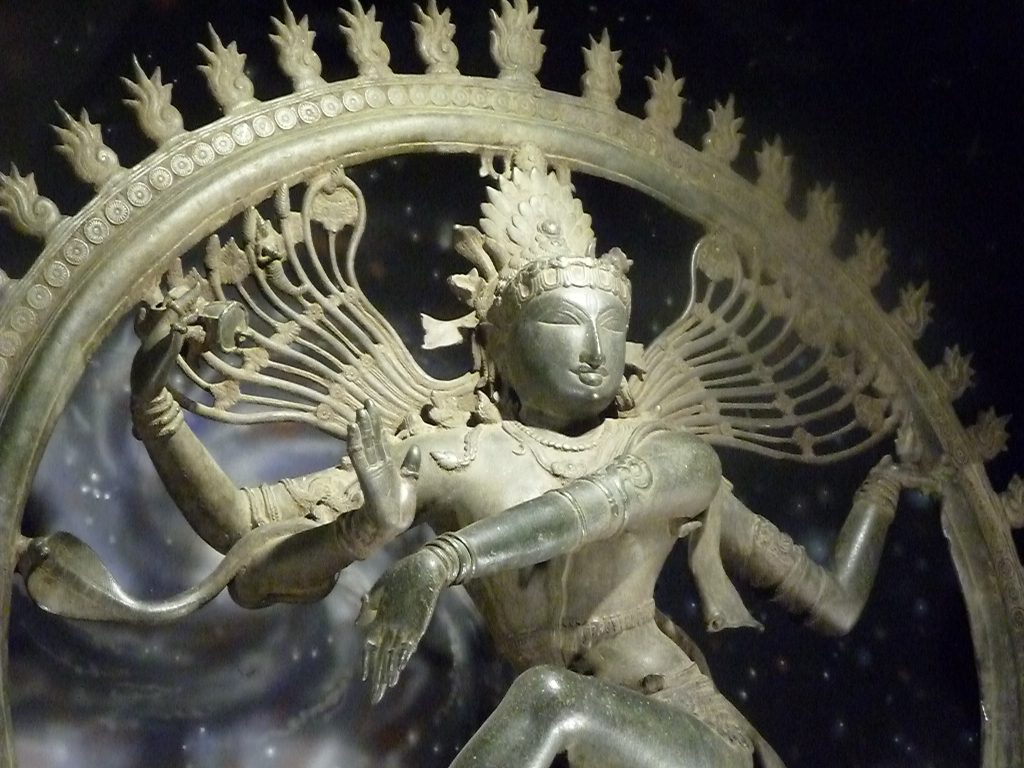The myth cycle of Siva in the pine forest is a dynamic and complex narrative, often viewed from a Western lens as paradoxical. Not only the narrative, but also Siva himself, is commonly viewed as inconsistent, as much of what he represents can be seen as opposites; such as his role as both creator and destroyer (O’Flaherty 1969a: 303). Whether this view derives as an aftereffect from the translation of the text from Sanskrit to English, or from an overly simplistic interpretation of Siva mythology, Siva should not be understood to reside consistently on the either end of a spectrum, but should rather be considered more appropriately as existing in his “dual nature” (O’Flaherty 1969a: 306). Siva must be thought of not in terms of concrete opposites, as either black or white, but as a fluid development. Handel and Shulman (211) state that “the god who breathes in is the same god who breathes out… he is never not in process”. Siva should be regarded in this sense; he should not be observed as static.
Hindu mythology is a reflection of the Hindu worldview, offering readers a look into the complex history, social norms, rituals and belief systems of Hinduism (O’Flaherty 1981:1). It is diverse; there are often many variations and many meanings in each myth cycle. Meaning in Hindu mythology should not be understood from a singular viewpoint, but should be understood on multiple levels and within multiple contexts, understanding that there is not one singular meaning in each myth cycle (O’Flaherty 1981:2). Understanding this, along with the dual nature that O’Flaherty references, is crucial to understanding the pine forest myth cycle, specifically in regards to Siva’s seemingly conflicting traits of asceticism and eroticism, which are heavily presented in the narrative.
The pine forest myth cycle has many variations, however, there is a fairly consistent storyline that most variations follow. The most common understanding is that the deity Siva enters the forest of pines begging for alms. The wives of the sages who live in the forest see him walking around, naked and ithyphallic, and are very attracted to him. In much the same way, the sages are attracted to Visnu, who had transformed into a beautiful woman. When the sages realize that their wives are full of lust for this beggar, whom they did not know was Siva at the time, they become upset. They proceed to attack him, both in the physical sense, as well as curse him, which causes his phallus to fall off. However, after realizing that the man is Siva, they begin to worship the fallen linga, and Siva teaches them how to obtain moksa. This overview is very simplistic, and does not do justice to the complexities and controversies existing within the different variations of the text.
In her book, SIVA The Erotic Ascestic, O’Flaherty outlines three broad groupings under which differing variations of mythology can be categorized. Firstly, the idea of Siva as a “false ascetic” (1981:173), whose purpose for being in the forest is to seduce the sages’ wives for his own pleasure. He is depicted in these versions of the narrative as very aroused and erotic, and in some tellings, Siva even forced himself upon the sages’ wives (or daughters, in certain narratives). This lust that Siva has for the women is sometimes explained by him being unsatisfied with his sexual relationship with his wife (O’Flaherty 1981:173-175). This presentation of Siva as a false ascetic focuses primarily on one extreme of his seemingly contradictory traits, as both erotic and ascetic. Secondly, O’Flaherty presents Siva as the “passive ascetic” (1981:173). This title encompasses narratives that portray Siva not as the seducer, but as the one being seduced. In these variations, the wives fall in love with him soon after seeing him in the forest. However, despite the wives often blatant desire for him, he disregards their advances. In one account of the narrative, he does not notice them because he is busy meditating, and in another account, he avoids their advances by physically running away from them (O’Flaherty 1981:175-176). The narratives under this category clearly portray Siva as opposite to the seemingly unashamed erotic persona previously examined, and highlights instead the other end of the spectrum, showing him as completely ascetic and without desire for the sages’ wives. Thirdly, O’Flaherty offers a categorization that she titles “The apparent lust of the ascetic Siva” (1981:178). Presenting a balance between the two extremes, Siva is observed within this category as pretending to be lustful, while really remaining ascetic. Interpretations of his purpose in this manipulation often correlate back to the sages. It is commonly seen as Siva attempting to present the sages with a crucial message about their wives’ impurity, and he masquerades as lustful in order to seduce them, and illustrate how unfaithful they are to their husbands. In other versions of the myth, the sages’ power is held within the chastity of their wives, and by seducing them, Siva is able to take power from the sages in order to use it against his enemies (O’Flaherty 1981:178-179). Ultimately, Siva is using an erotic means to seduce the wives that does not reflect his true intentions or desires, leaving him as both erotic and ascetic.

The pine forest myth cycle presents many sexual symbols which can be observed both directly and indirectly, regardless of which variation of the narrative is being examined. In this myth collection, Siva is consistently presented wandering the forest completely nude, with an erect phallus, which in many variations of the narrative falls off as a result of being cursed by the sages. In many shrines dedicated to Siva today, it is not uncommon to see a linga statue, which is a common symbol used to represent Siva. The sages worshipping the fallen linga after realizing the true identity of the beggar is often thought of to be the origination of linga worship (Handelman and Shulman 33). Further sexual symbolism can be seen when Siva uses sexual mannerisms as a way to teach the sages a lesson about chastity and lead them to enlightenment (O’Flahery 1981: 204). Again, there is a sense of balance between the opposing ideas of eroticism and asceticism, as Siva’s methods of teaching appear to contradict the message he is trying to present. Another meaning that can be interpreted from certain variations of the text offers that Siva was intending the show the sages that they must give up their tapas, which are obtained through strict purity,and instead focus more on their wives (O’Flaherty 1981:200). Again, this interpretation centers around balancing purity and sexuality, as it presumes that while the sages are attempting to be liberated through purity, they are too extreme, and by doing so they are neglecting other important areas of their life. The sages, who focus intently on purity, are somewhat ironically liberated through linga worship at the end of the narrative (O’Flaherty 1981:201), which points further to the importance of balance.
The sexual nature of the myth cycle is not just seen in obvious, overt symbolism. In fact, the entire narrative is based around erotic conversations and connotations. Early on in many variations of the narrative, it is stated in some form that Siva is very handsome and that the sages’ wives are very physically attracted to him. In the same way, Visnu helps Siva by transforming into a beautiful woman in order to seduce the sages (Handelman and Shulman 5). With both the sages and their wives being seduced by the gods, Siva and Visnu reunite, and when the sages recognize that their wives are being unfaithful to them, they become angry. In this version of the narrative, when they attempt to fight Siva, they lose their tapas, which they had dedicated much time and effort into gaining through purity. Eventually, they become wiser and apologize to Siva, and he directs them to return to their tapas, as they had learned the lesson he went to teach them (Handelman and Shulman 10-14). This blending of eroticism and ascetism shows the balance of Siva’s being, illustrating again that he does not fall to one extreme, but most often exists as both natures, in a balance. The linga is frequently seen as an erotic symbol, but when looked at more closely, is also a representation for chastity. The idea of chastity connects with concepts of self control and discipline, and the erect phallus represents the containment of semen, which is a symbol itself of chastity. Therefore, Siva’s chastity is not in conflict with his eroticism, but is rather complimented and strengthened by it, allowing chastity and sexuality to coexist (O’Flaherty 1969a:308-309).
This myth cycle is important in the Hindu tradition, as it draws on prevalent concepts in Hinduism such as sexuality and chastity. As seen in the narrative, sexuality and chastity are not viewed as opposing forces in Hinduism; they are not opposites, but are thought to work together, and are connected (O’Flaherty 1969a:311). Just as Siva represents two concepts that appear contradictory, a Hindu’s role and responsibilities in society are often seen as conflicting, and this myth cycle offers guidance to the Hindu reader on how responsibilities need to coexist, and cannot all be obtained independent of one another. O’Flaherty (1981:38) explains how the responsibility of the sages to be chaste but yet still devoted to their wives presents an ideal that is not realistic. In the same way, the societal demands for Hindus to be both involved in their family life in the householder stage but yet also fully dedicate themselves to seeking god as a renouncer cannot be attained. One application for Hindus that can be drawn from this myth cycle is the importance of balance, and recognizing how two ideals must coexist.
Mythology plays an important role in Hinduism, and it has been argued that the lessons found in the mythology of Siva specifically “lie at the very heart of Hinduism” (O’Flaherty 1981:1). The depth offered in Hindu mythology is complex and layered, as is evident in the pine forest myth cycle. Under further examination, the seemingly opposing forces at play act to balance each other, and it is evident that what may at first appear paradoxical can exist as complimentary. Although Siva represents many opposing forces in different myth cycles, he most clearly represents erotism and asceticism in the pine forest myth cycle. Despite the fact that there is not one singular clear meaning or interpretation of the narrative, but rather many alternative forms that differ greatly from each other, there are evident overarching themes that remain consistent throughout the myth cycle. From a Western perspective, there is often a misconception that Siva is an inconsistent deity (O’Flaherty 1969a: 303). The mythology of Siva, although complex, should not be viewed with the intent of finding one singular meaning or interpretation, but needs to be viewed with an understanding of the complexities and variations that exist.
REFERENCES AND FURTHER RECOMMENDED READING
Clothey, Fred W., and Bruce J. Long (1983) Experiencing Siva: Encounters with a Hindu Deity. Columbus: South Asia Books.
Handelman, Don, and David Schulman (2004) Siva in the Forest of Pines: An Essay on Sorcery and Self knowledge. New York: Oxford University Press.
O’Flaherty, Wendy Doniger (1976) The Origins of Evil in Hindu Mythology. Berkeley: University of California Press.
— (1969a) “Asceticism and Sexuality in the Mythology of Śiva. Part I.” History of Religions, 8:300-37. Accessed January 29, 2020. www.jstor.org/stable/1062019
— (1969b) “Asceticism and Sexuality in the Mythology of Śiva. Part II.” History of Religions, 9:1-4. Accessed January 29, 2020. https://search-proquest-com.ezproxy.uleth.ca/docview/1297348748?accountid=12063.
— (1971) “The Submarine Mare in the Mythology of Śiva.” Journal of the Royal Asiatic Society of Great Britain and Ireland, 1:9-27. Accessed January 29, 2020. www.jstor.org/stable/25203231
— (1981) Siva, the Erotic Ascetic. New York: Oxford University Press.
Related Topics for Further Investigation
Linga
Parvarti
Siva
Shaivism
Visnu
Noteworthy Websites Related to the Topic
https://en.wikipedia.org/wiki/Bhikshatana
http://fredoniaflame.blogspot.com/2013/01/doniger-hindu-myths-puranic-myths-of.html
https://www.bbc.co.uk/religion/religions/hinduism/deities/shiva.shtml
https://en.wikipedia.org/wiki/Lingam
This article was written by: Kayley Grasmeyer (Spring 2020) who is solely responsible for its content.










